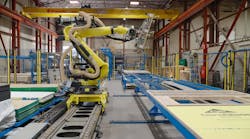Under its Existing Buildings: Operations and Maintenance (EB:O&M) rating system, the U.S. Green Building Council’s Leadership in Energy and Environmental Design (LEED) certification system allows as many as three credits for “system-level metering.” These credits, which are available under performance measurement within the Energy and Atmosphere category, mean that nearly 8 percent of the necessary credits for LEED-EB:O&M are associated with metering and/or submetering.
How many times have you thought about applying to a building automation system (BAS) a check metering strategy that monitors kilowatt demand and kilowatt hour consumption? Now compare this total to that of the utility bill. Given the overhead cost of utilities, “check metering” is not only a good strategy but also plants roots for a BAS.
Meanwhile, since sub-metering hit the market, its usage has grown dramatically in functionality and usefulness, providing great value to facility managers’ and owners’ front-line energy data gathering. Considering we’re in an era of rising utility costs and tightening budgets, today’s submeters are coming out of the electrical room on to the factory floor and into building lobbies to give those who “need to know” a clear look at actual energy usage.
To the certification-conscious owner LEED might be a bit of a stretch, so recommending application for Entergy Star might be a better alternative. The Energy Star rating still offers “bragging rights” because the building owner joins a team of 75,000+ buildings in the United States that are characterized for implementing efficiencies. These buildings provide fertile ground for submetering-based performance assessment through:
• Data collection and management
• Establishing performance baselines
• Auditing and analyzing energy patterns and trends
• Normalizing energy data for fair and accurate comparisons.
Don’t forget to thank Al Gore for inventing the Internet! The World Wide Web enables energy monitoring and data presentment anywhere. Visual enhancements through dashboards make it easy for executives to see the impact of kilowatt hours, kilowatts, peak demand, power factor, and other energy measurements that are registered in real time and with good historical reference.
Likewise, the sustainability-conscious client can also graphically monitor a building’s carbon footprint” with dashboard software. Facility managers can graph a building’s carbon dioxide, sulphur dioxide, and nitrous oxide emissions. These observed levels keep everyone thinking “green.”
The facility world is undergoing dramatic changes, and they’re all being driven by the need to save energy in an effort to keep reducing operating costs. Similarly, building managers will be overwhelmed by the array of energy programs now proliferating, and the ways that sub-meters and automatic meter readings can help them measure, verify, and report compliance with corporate energy objectives.
It all comes down to the old adage, “You can’t manage what you don’t measure!”
Richard A. “Dick” Starr, LEED AP, is CEO and president of the Enterprise Corporation (also known as Enterprise HVAC Service & Control). The company is a design/build/maintain contractor located in the Cleveland, OH area. Enterprise is a Linc Service Contractor, Tridium Systems Integrator, and NEBB certified air/water balance agency. Starr also sits on the national boards of both the Mechanical Contractors Association of America (MCAA) and the Mechanical Service Contractors of America (MSCA). Enterprise HVAC Service & Control was selected as Contracting Business magazine’s 2011 Commercial Contractor of the Year. For more information, visit www.enterprisehvac.com.








